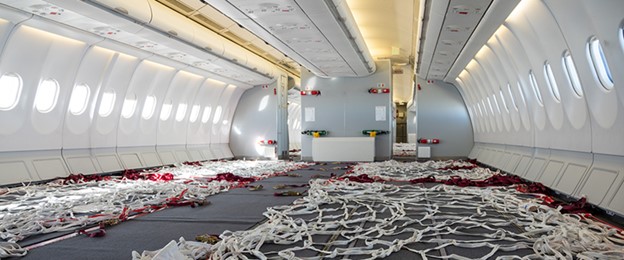The Airbus A340 is a wide-body passenger airliner powered by four Rolls-Royce Trent 900 engines capable of flying long-range routes. It was manufactured in several variants before it was discontinued, with the largest seating 380 passengers. Here's more about this plane.
History of the Airbus A340
The A340 was developed because of the increasing demand for long-range aircraft. At the time, the only aircraft that could fly non-stop from Europe to North America were four-engine aircraft, such as the Boeing 747 and the McDonnell Douglas DC-10. The A340 offered a more efficient and economical alternative to these aircraft.
The Airbus A340 was produced at Airbus's plant in Toulouse, France, beginning in 1991 and was an immediate success when it entered service in 1993. It became one of the most popular long-range airliners in the world and was particularly popular with commercial and charter airlines that operated long-haul routes between Europe and Asia. Production ended in 2018 when the A340 was replaced by the Airbus A350, a more fuel-efficient twin-engine aircraft.
Key Features
Here's an overview of some of the key features of this aircraft.
- Four-engine design allowed for a longer flight range
- Wide-body fuselage for comfortable seating
- Advanced avionics and flight systems
- Efficient engines
- Large passenger capacity
- Comfortable cabin
- Reliable and efficient
Who Flew The Airbus A340?
The Airbus A340 was operated by many airlines around the world, including:
- Air France
- Alitalia (Now ITA)
- American Airlines
- British Airways
- Cathay Pacific
- Delta Air Lines
- Emirates
- Etihad Airways
- Lufthansa
- Qantas
- Saudia
- Singapore Airlines
Airbus A340 Variants
A340-200
Entering service in 1993, the A340-200 seated up to 295 passengers and is the original version of the A340. It had a range of 7,400 nautical miles (13,700 km) and was discontinued in 2008.
A340-300
Also entered service in 1993, the A340-300 is a stretched version of the A340-200 and was the most popular variant of the A340. It had a range of 7,700 nautical miles (14,200 km) and could seat up to 333 passengers. The A340-300 was discontinued in 2013.
A340-500
Introduced in 2002, the A340-500 is an extended-range version of the A340-300. It had a range of 12,500 nautical miles (23,100 km) and could seat up to 313 passengers. The A340-500 was discontinued in 2016.
A340-600
Also introduced in 2002, the A340-600 is the most extended edition of the A340. It had a range of 13,400 nautical miles (24,800 km) and could seat up to 380 passengers. The A340-600 was discontinued in 2018.
A340 Cargo Version
Unlike other models, Airbus never manufactured a cargo version of the A340. There are a few reasons why:
- Fuel efficiency: The A340 is a four-engine aircraft, which makes it less fuel-efficient than two-engine aircraft like the Boeing 777F. This is a significant disadvantage in the cargo market, where fuel costs are a major factor.
- Market demand: The A340 was never as popular as the Boeing 777, so there was less demand for a cargo version.
- Development costs: Developing a new cargo aircraft is expensive, and Airbus likely decided that the market for an A340 freighter was not large enough to justify the cost.
Cargo Shipping During Covid
Even though Airbus didn't manufacture a cargo version, some A340 aircraft had brief stints as cargo planes during the COVID-19 pandemic. When passenger demand for air travel plummeted, many airlines grounded their aircraft and laid off staff. However, demand for cargo actually remained relatively strong, including the shipping of essential goods, such as critical medical supplies, food, and personal protective equipment.
To meet the demand for cargo transport, some airlines began flying cargo in their A340s. This was done by removing the seats to make room for cargo containers. The A340 had a large passenger capacity, and that space supported the cargo-focused configuration well.
Here are a few of the airlines that used A340s as cargo shipping planes during the pandemic:
- Air France
- Lufthansa
- Turkish Airlines
- Cathay Pacific
- Singapore Airlines
These airlines could keep their A340s flying, and their crews employed during uncertain passenger travel times, a significant benefit for the airlines and the aviation industry.
Safety Record
The Airbus A340 has a good safety record. There have been no fatal accidents involving the A340 since it entered service in 1993. However, some airport runway incidents occurred but were caused by various factors, including weather conditions and pilot error. Aviation experts consider the aircraft to be safe.
Service Status
The Airbus A340 began to be withdrawn from service in the early 2020s. This was due to several factors, including the increasing popularity of more efficient twin-engine aircraft and the high cost of operating four-engine airliners.
As of March 2023, only a handful of A340 aircraft remains in service. These aircraft are operated by several airlines, including Lufthansa, Etihad Airways, and Saudia. It is expected that the A340 will be completely withdrawn from service in the next few years.
The A340 was a successful passenger aircraft that helped make long-range air travel more common. It was reliable, efficient, and comfortable, and it helped to make long-haul flights more affordable and accessible. The A340 will be remembered as one of the most important airliners of its generation.
We're all things cargo shipping at Alaska Air Forwarding. If you need to ship goods to Alaska anywhere in the state, Alaska Air Forwarding can help you get the job done year-round. Contact us or get a quote online to get started.






